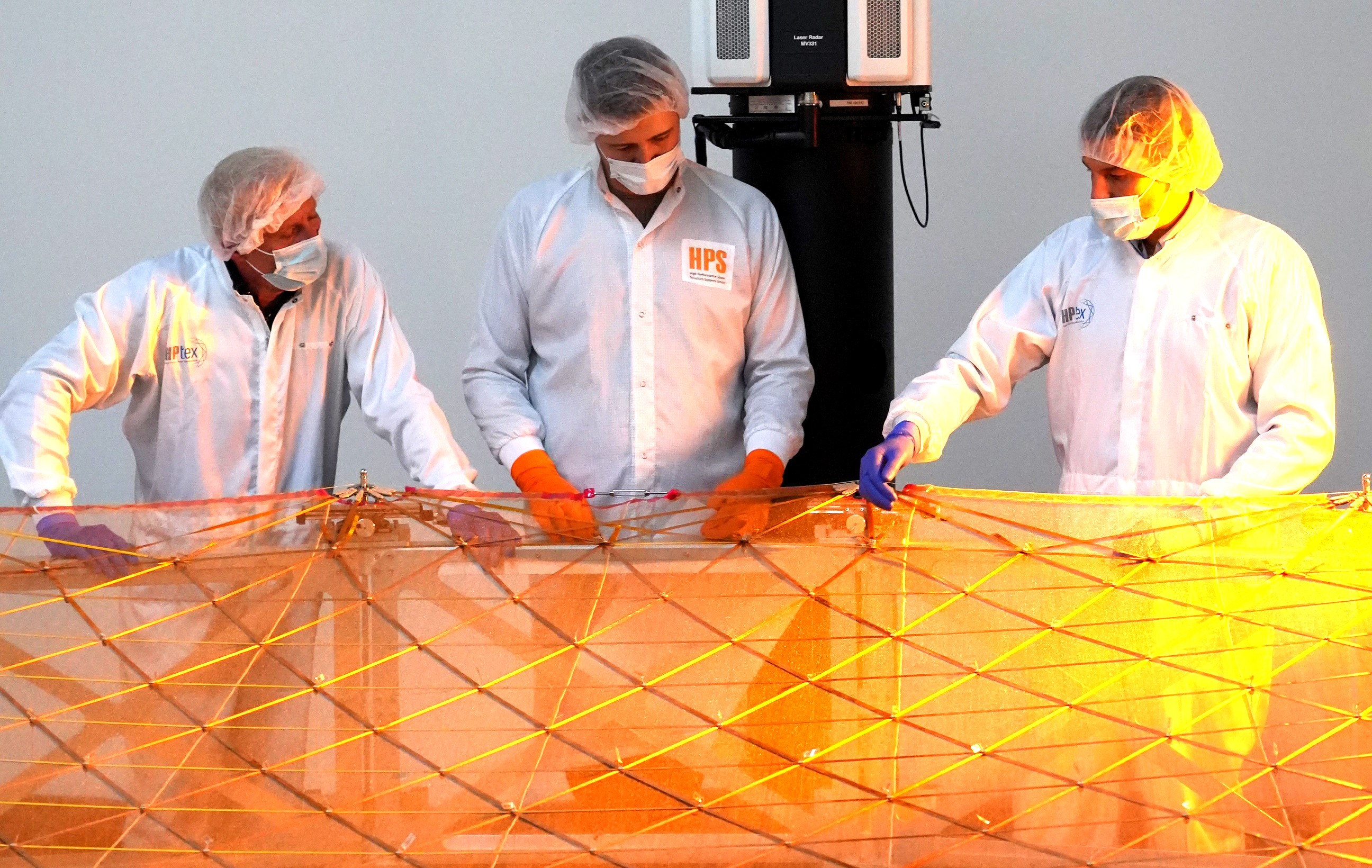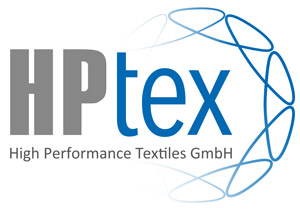Innovative Raumfahrttechnologien live entfaltet und präsentiert.
November 2025

Innovative Raumfahrttechnologien live entfaltet und präsentiert.
November 2025
Am Mittwoch, dem 19. November 2025, empfing die HPS GmbH auf ihrem Messestand der Space Tech Expo 2025 in Bremen den DLR-Raumfahrtchef Dr. Walther Pelzer. Die CEOs und führende Vertreter von HPS München und deren Joint-Venture HPtex Münchberg informierten die hochrangigen Gäste der deutschen Raumfahrtagentur über die neuesten Fortschritte im Bereich der weltraumtechnischen Innovationen.
Im Rahmen des Besuchs wurden den Gästen zwei herausragende Entwicklungen live vorgestellt (siehe Bild):
Beide Technologien wurden zeitgleich und live am Stand als eindrucksvolle Demonstration entfaltet; sie stammen aus renommierten ESA-Technologieprogrammen wie GSTP und ARTES, welche den europäischen Raumfahrtunternehmen als Basis für stetige Wettbewerbsfähigkeit bieten.
HPS und HPtex waren Teil des von @BavAIRia großartig organisierten und schön arrangierten bayerischen Gemeinschaftsstandes.
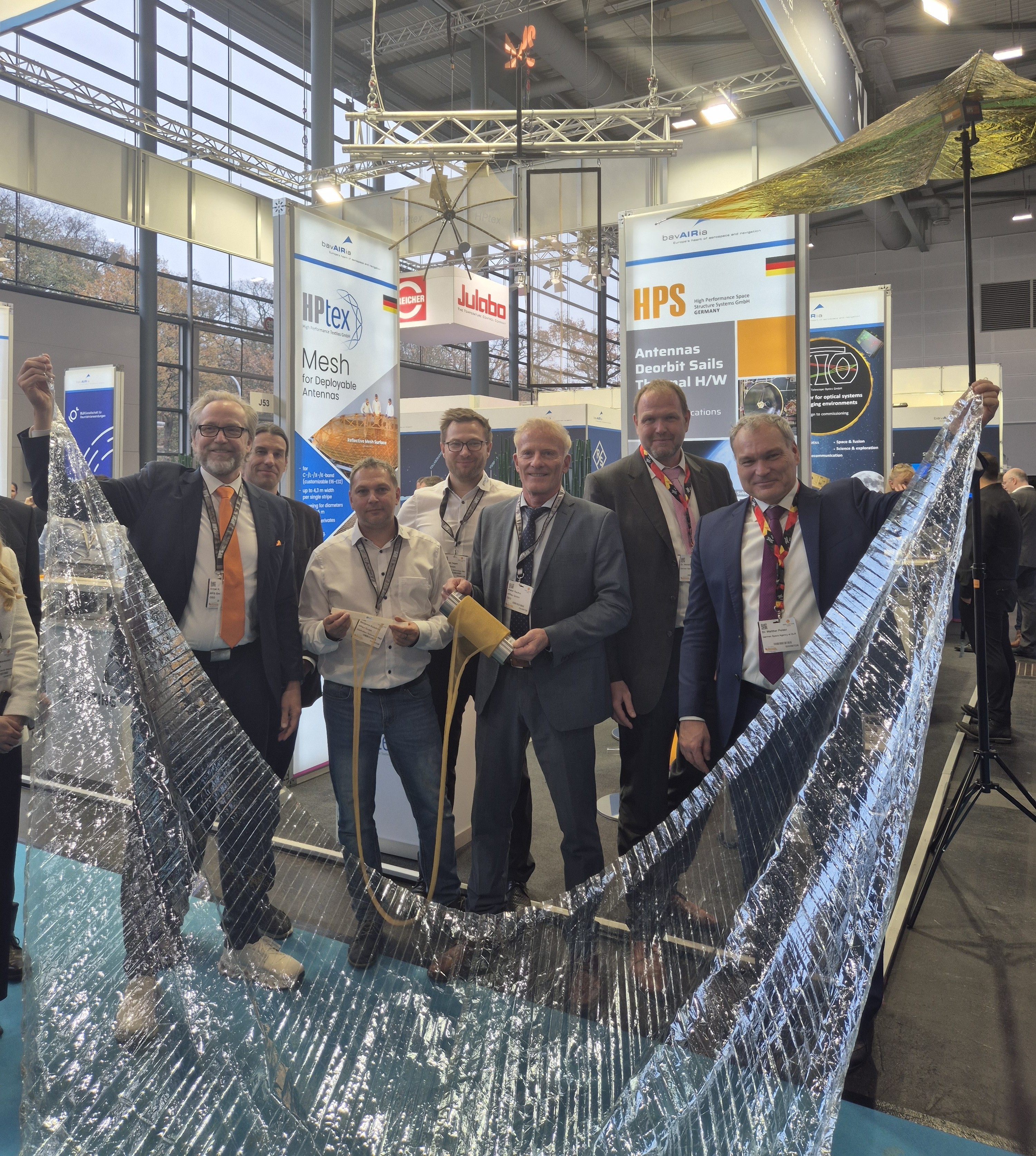
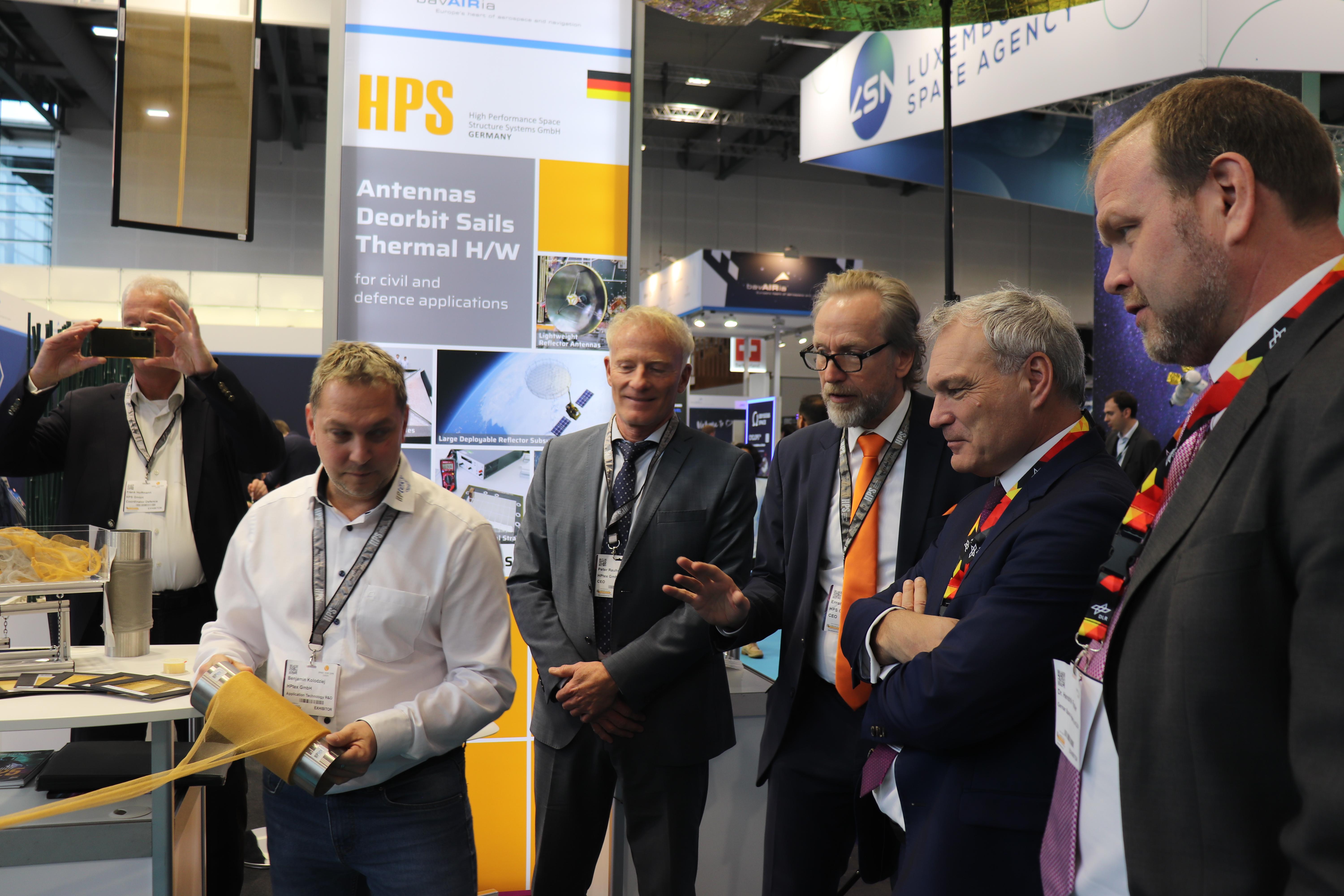
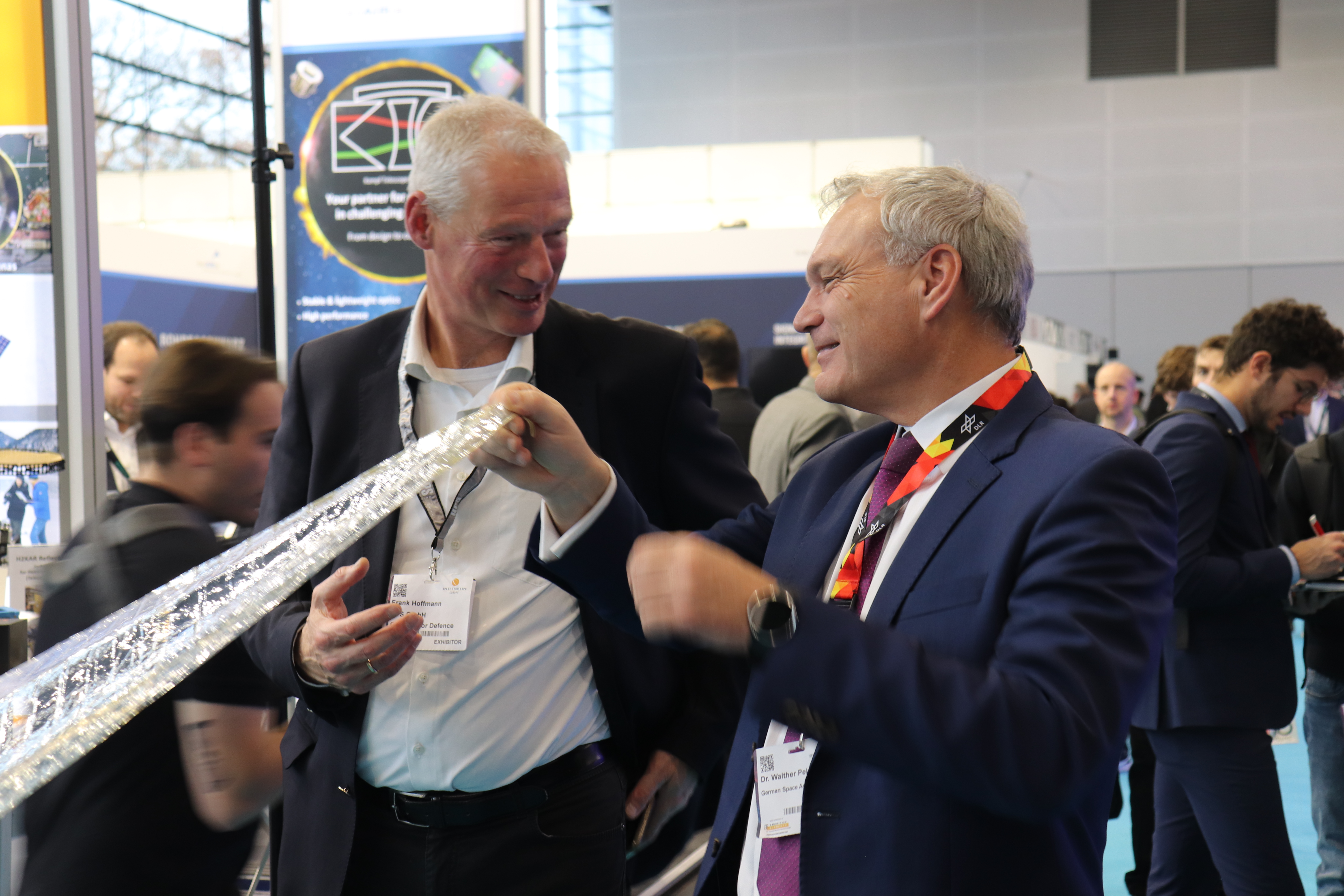
Inspection of the HPtex-Mesh for ESA’s Next-Gen Earth Observation Satellite Successfully Completed
June 2025
After months of precision manufacturing at HPtex GmbH, a specialist in space-grade textiles based in Upper Franconia, Germany, a major milestone was reached on June 24, 2025, for the European space mission CIMR (Copernicus Imaging Microwave Radiometer). A large-scale inspection of the mission’s deployable antenna mesh took place in the newly commissioned cleanroom assembly hall at HPS headquarters in southern Munich.
At the heart of the event: the newly developed Universal Space Mesh USM TUCH 32 – an ultra-fine metallic mesh tailored specifically for CIMR’s demanding Ka-band requirements. Available in two variants (20 µm and 25 µm wire diameters), this mesh features E32 needle fineness (32 needles per inch), an exceptionally low mass of approximately 40 g/m², and dimensions of 10.2 x 9.5 meters – making it one of the largest high-performance space meshes of its kind worldwide. The individual mesh stripes were sewn by HPtex with its reengineered sewing machine in a now fully automated and touchless sewing process. Thanks to the large knitting width (over 4 m) of the in-house high-performance knitting machines only two seams have been necessary to assembly this large mesh.
The mesh itself is woven using high-purity wire from LUMA WIRE TEC in Sweden, a long-standing partner of HPS and HPtex.
The inspection was attended by a top-tier delegation, including representatives from:
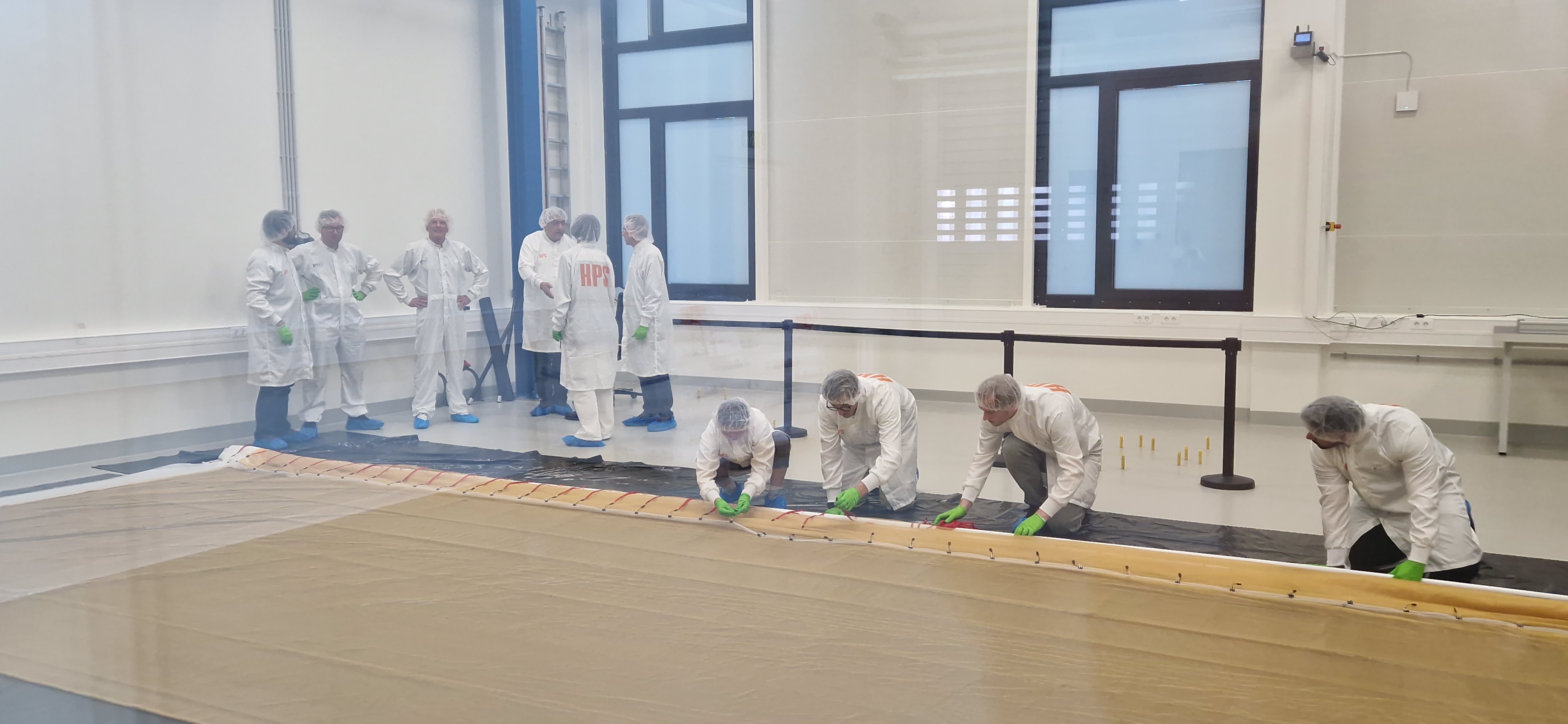
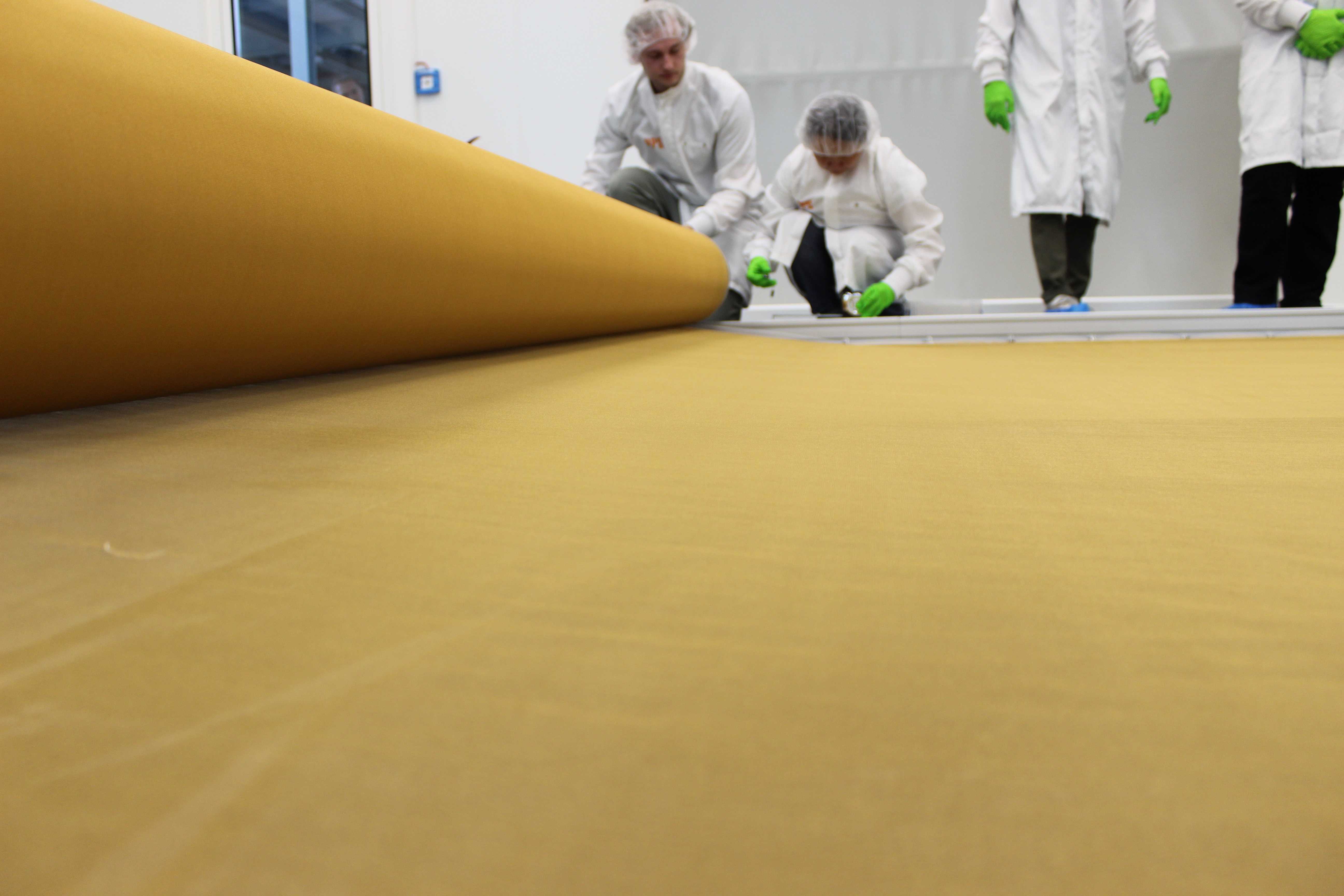
This milestone marks the culmination of four years of dedicated development under the CIMR program, building on six prior years of preparatory research and prototyping. Over the course of the project, hundreds of mechanical tension tests were conducted—primarily using HPS’s proprietary testing setup, which has been steadily refined over the years. In parallel, hundreds of RF tests were carried out, culminating at ESA/ESTEC, using their cutting-edge, high-precision RF characterization facility, to fine-tune the mesh’s electromagnetic properties. Cyril Mangenot, former RF specialist at ESA/ESTEC and one of the earliest supporters of a European LDRS solution on the agency side, supported the mesh development for HPS with all his experience.
The next step: mating the mesh with the Engineering Qualification Model (EQM) of the cable network provided by LSS. CIMR is currently in Phase C/D, with the Critical Design Review (CDR) scheduled for the first half of 2026.
This achievement exemplifies the strength of European collaboration in space technology. From materials science to RF performance, every aspect of this “dream team” effort—including ESA, TAS-IT, HPS, HPtex, LSS, and others—has contributed to an outstanding result.
HPtex is now the central European source for supplying high-performance space meshes to customers across the globe – from the Americas to Asia – and demonstrates once again that world-class aerospace innovation is alive and thriving in Bavaria.
CIMR-LDRS: The lighthouse project for non-dependence in European space travel enters the production phase of the qualification model (EQM) as planned
April 2025
Long before an unspeakable bloodbath sealed the end of peaceful life in Eastern Europe in 2022, the demand for technological “non-dependence” had already conquered a top position among the strategic priorities in German and European space travel. The focus was particularly on large reflector antennas that could be deployed in space, suitable for missions of all kinds.
The history of this German technology for Europe began more than a decade ago with SCALABE, a technology development funded by ESA, and SMERALDA (SME’s Radar and Large Deployable Antenna), a study funded by the German Space Agency with significant participation by antenna specialist HPS GmbH. Through further technical chapters of successful concretization of the goal with significant support from ESA and the EU, the Munich-based company finally led a consortium of mostly medium-sized partners from eight countries to the spectacular win of the 115 million euro contract from Prime`sThalesAlenia Space (TAS) for “CIMR LDRS” (Large Deployable Reflector Subsystem) in 2020: the world’s largest rotating deployable reflector antenna construction for the EU’s Copernicus Imaging Microwave Radiometer (CIMR) lighthouse project for observing land, ice and oceans, particularly the Arctic, from space under the management of the European Space Agency (ESA). The LDR subsystem consists of a reflector, arm, deconvolution electronics, cabling, various hold-down mechanisms and thermal hardware.
After a long design phase and intensive iteration with the direct customer TAS in Rome and the end customer ESA, the go-ahead was given in phase C/D with the completion of the first so-called “Manufacturing Readiness Review” for the construction and testing of a qualification model (Engineering Qualification Model, EQM). In these days of spring 2025, HPS has now finally entered the intensive phase of manufacturing the EQM.
Challenges on the way to new shores
The technical challenges were and are immense, as the goal is nothing less than a deployable reflector construct for high frequencies (Ka-band) with a diameter of eight meters on an equally deployable eight-meter-long arm that rotates around its own axis eight times per minute in orbit. This results in extreme requirements such as an RMS (Root Mean Square) value for the surface accuracy, which must be much smaller than 1/10 mm over the entire 50 m² reflector surface, or a maximum permissible deviation of the 8 m distant arm tip of just 10 mm from the nominal value, including vibrations, centrifugal force and thermal deformations.
The challenges of managing the various aspects of the project were and are no less demanding. The program management of the CIMR team from ESA and TAS has played a prominent role from the outset, while HPS GmbH, known for its heritage in institutional, military and commercial antenna construction – in addition to its own development work at arm and subsystem level – is responsible for managing the consortium of around a dozen SMEs, including such outstanding innovation drivers as Munich-based LSS GmbH for the deployable reflector assembly (DRA), based on a highly successful, long-standing development partnership. The lightweight carbon struts for the DRA come from the former Portuguese HPS subsidiary and now FHP, INVENT GmbH contributes the carbon fiber-reinforced tubes for the 8-meter deployable support arm (DAA), NanoSpace Switzerland develops and produces the high-precision yet stable, motor-driven joints of the arm, HPS Romania and INEGI Portugal the constructions for ground tests and transports (“MGSE”). In addition, HPS is responsible for providing the central element for the deployable reflector: the measurably best Ka-band MESH from HPtex that is available to buy in a 9m x 9m size – and, as a “made in Germany” product, transforms European non-dependence from vision to reality. Until then, a MESH in such dimensions had only been available in American production. Originally planned as an essential element of the German-European supply chain for CIMR, the joint venture HPTex GmbH (JV of Iprotex GmbH & Co. KG and HPS GmbH), founded in 2020, now sells its mesh products worldwide, especially in Asian and continental American countries. The EQM mesh for CIMR recently came out of HPtex production.
The most important components (DAA and DRA) will be ready by the end of the year, and the series of tests will begin early in 2026.
“If you want to be ahead, you shouldn’t be afraid of the unknown” (Ernst K. Pfeiffer)
When CIMR sets off on its mission in 2029 on board a Vega C in a sun-synchronous orbit to observe ice sheets and snow, among other things, from dawn to dusk, Europe will not only benefit from the knowledge gained from the project, but also from the certainty of having mastered the step towards technological LDRS independence. LDRS are also products for a range of military applications that can contribute to an increased defense capability, especially in these years. HPS CEO Ernst K. Pfeiffer sees this as a milestone that goes far beyond the immediate success of the project: “This space project is clear proof that the mentality of all those involved in the project – both industry and institutions – is completely different to the risk aversion that the public normally attributes to Germany in particular, and to some extent also to ESA. Not being afraid of the unknown is the first key to success. Way up front is where it´s getting dark. Especially in space. But not only there.”
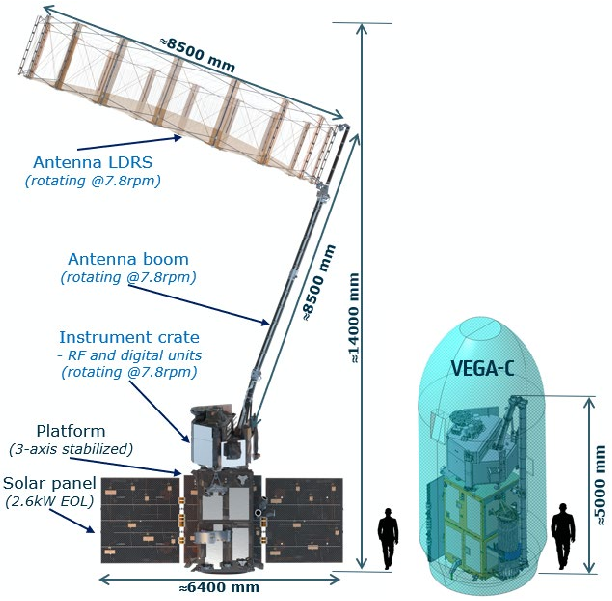
November 2024
German space agency chief Dr. Walther Pelzer and DLR delegation focus on visit to HPS Group
During the traditional DLR delegation round on the opening day of the Space Tech Expo in Bremen, the head of the German Space Agency at DLR, Dr. Walther Pelzer, focused his attention on SMEs in the German space industry. Special attention was paid to the innovation forge HPS. And it was represented in groups: with HPS Germany (Munich), HPS Romania (Bucharest) and the joint venture company HPtex (Münchberg, Germany).
With reference to pioneering antenna projects such as HERA and EUCLID, company boss Ernst K. Pfeiffer emphasized the leading position Germany has gained in special antennas for space missions. HPS is also positioning itself as a leader in the commercial sector with the successful ADEO braking sail project, which ensures compliance with the new 5-year rule for satellite deorbiting and thus keeps the satellites ready for launch.
In his role as spokesman for German space SMEs, Ernst Pfeiffer also took this opportunity to emphasize the enormous importance of the DLR and ESA’s capability-enhancing technology programmes for SMEs as the innovation backbone of the industry. According to Pfeiffer, the precise promotion of the technological capabilities of SMEs via dedicated competition areas reserved for SMEs is irreplaceable.
Live demonstrations, e.g. of a functional model of the ADEO brake sail or a scaled model of a deployable large antenna reflector, supplemented by product demonstrations from HPS-Romania (e.g. radiator) and from HPtex’s MESH production (e.g. Ka-band mesh sample for use in the Copernicus mission CIMR) rounded off the visit program.
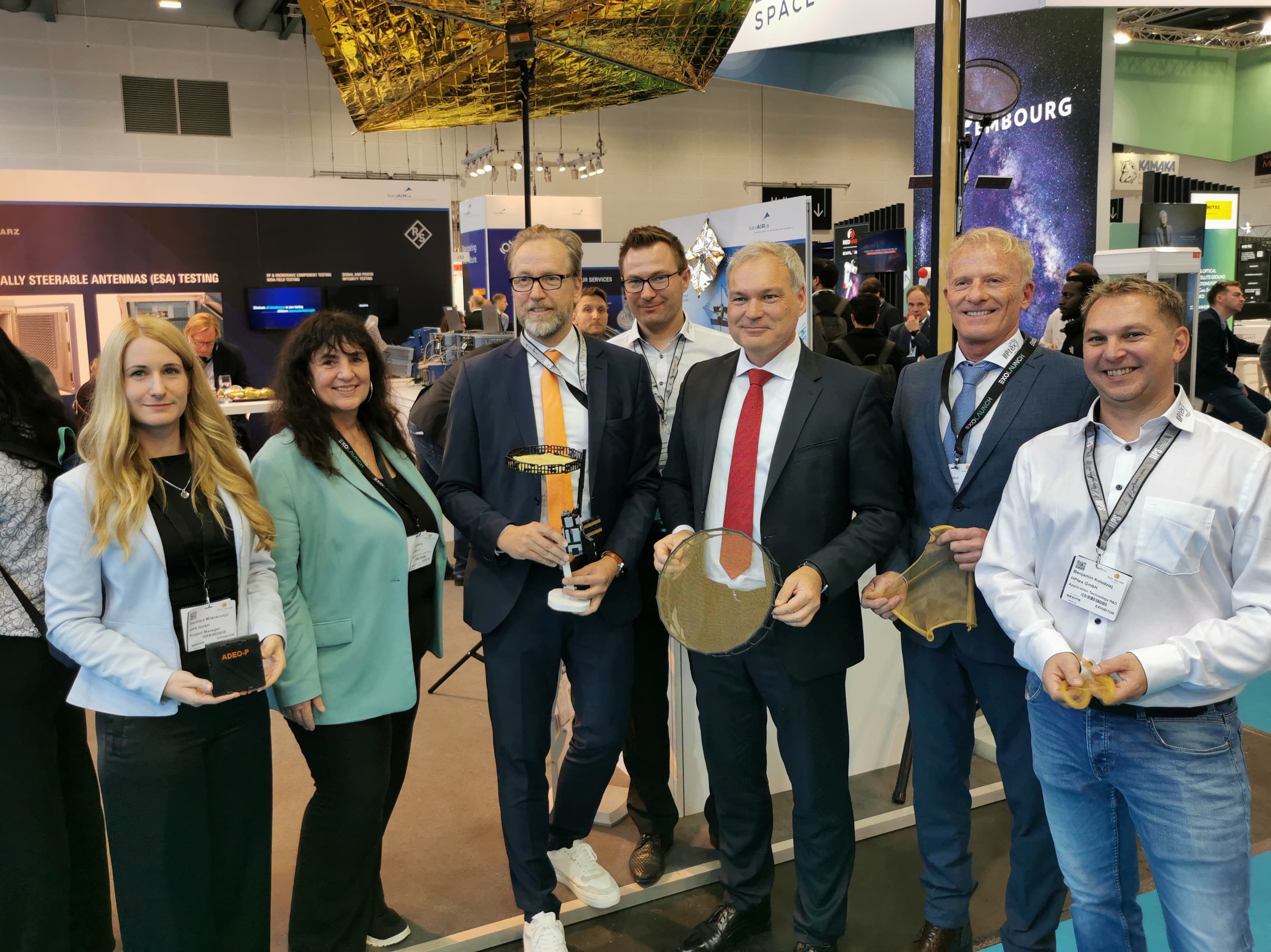
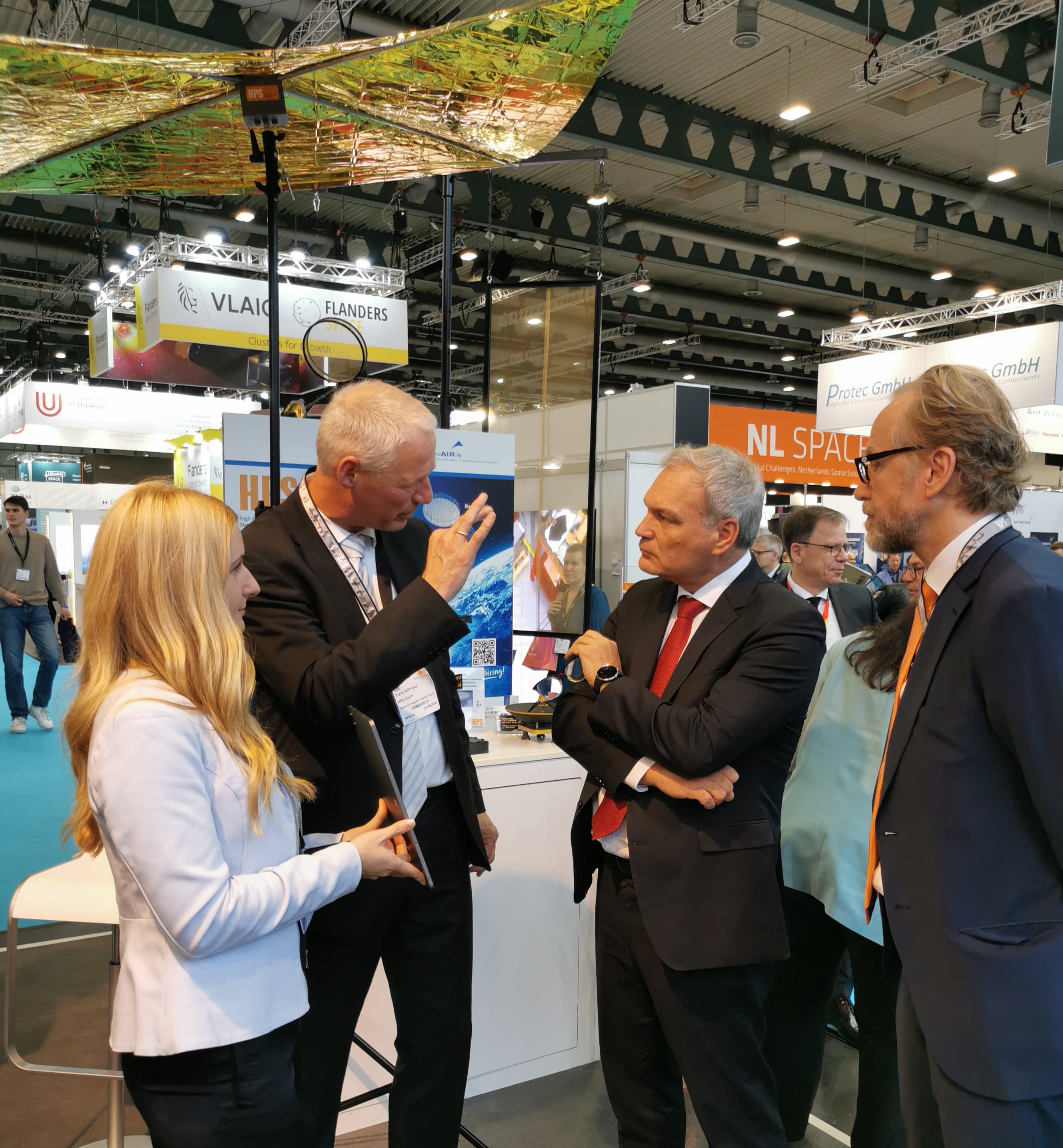
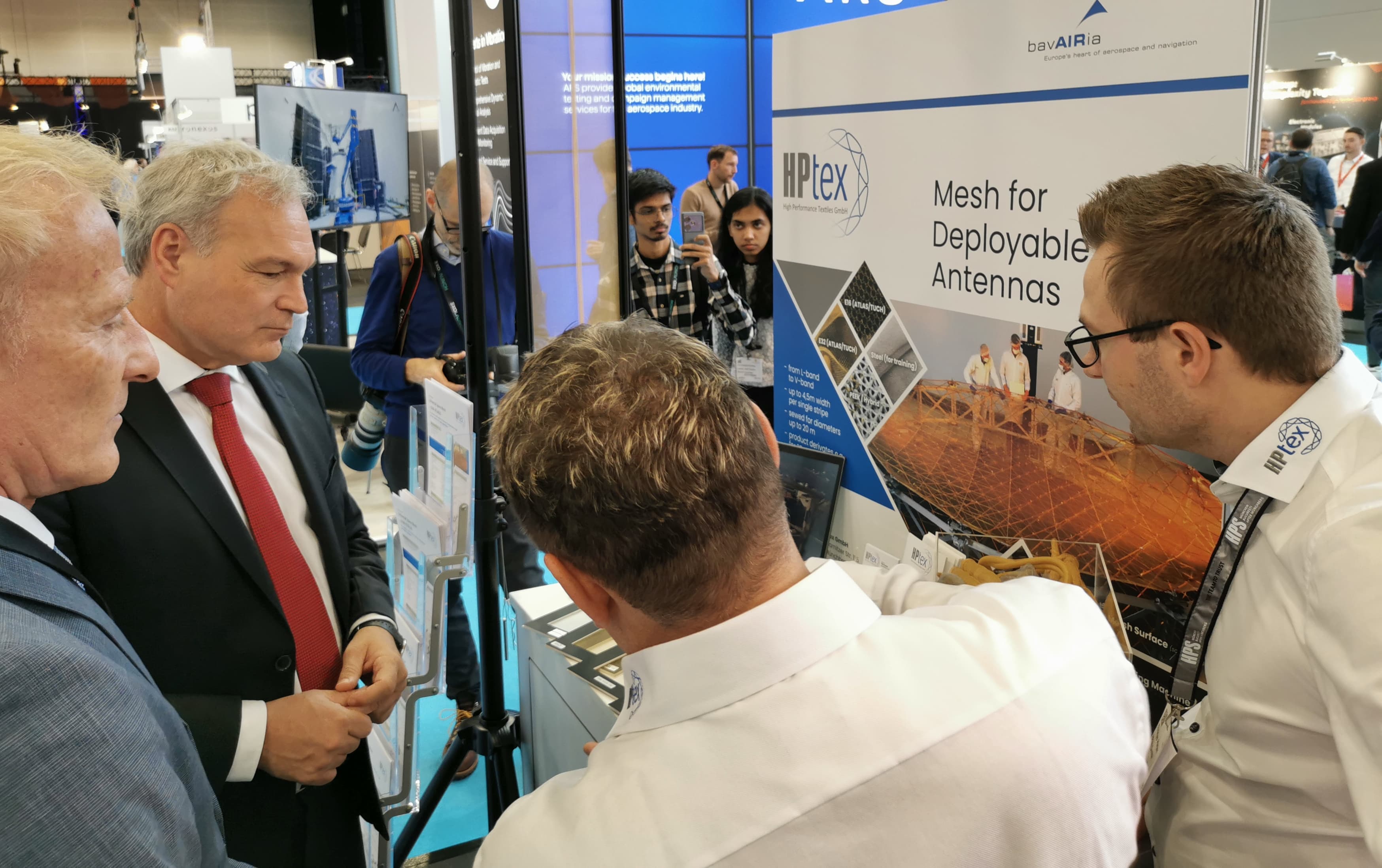
November 2024
New laboratory for mesh research at HPS
The Munich-based space technology company HPS is a joint venture partner of Iprotex-GmbH; both are equally involved in the joint company HPTEX in Münchberg near Bayreuth. This is where the flexible reflector material “MESH” is tailor-made and of the highest consistent quality for applications such as small and large deployable space antennas.
The market for mesh is divided among a small number of players worldwide. To survive here, continuous development is an essential prerequisite. HPS has therefore recently set up its own mesh research laboratory at its Munich headquarters on Hofmannstrasse. The initial team of two specialists is currently being expanded to include a further engineering position. The initial equipment of the laboratory for the further development and optimization of HPTEX mesh has already cost HPS 50,000 euros; among other things, investments were made in a mesh tension jig (stretch test rig) including an HD camera system. In addition, for yet another 50k euros the whole basement-area of the HPS building has been improved to host capacities for assembly work on ADEO brakesails in serial production.
Customized service is a top priority at HPS, so the new laboratory also carries out contract research, e.g. in a project called VMESH, in which a mesh for the very high frequencies in the V-band is being developed. The laboratory’s ability to carry out multiple iterated processes to measure the stretchability of antenna meshes is also unique on the market.
In addition, HPS is Europe’s only supplier of large deployable antenna subsystems with its own mesh production. The company’s flagship project is the ESA Copernicus Mission CIMR. HPTEX also serves customers from all over the world, including Europe, the USA, the United Arab Emirates, South Korea, Singapore and Taiwan, with the support of the new laboratory at HPS. The mesh is manufactured at HPTEX itself.
